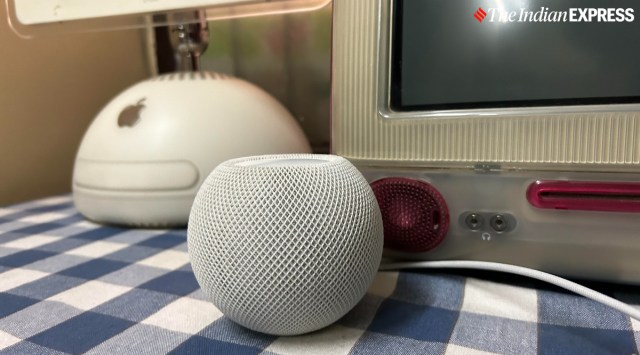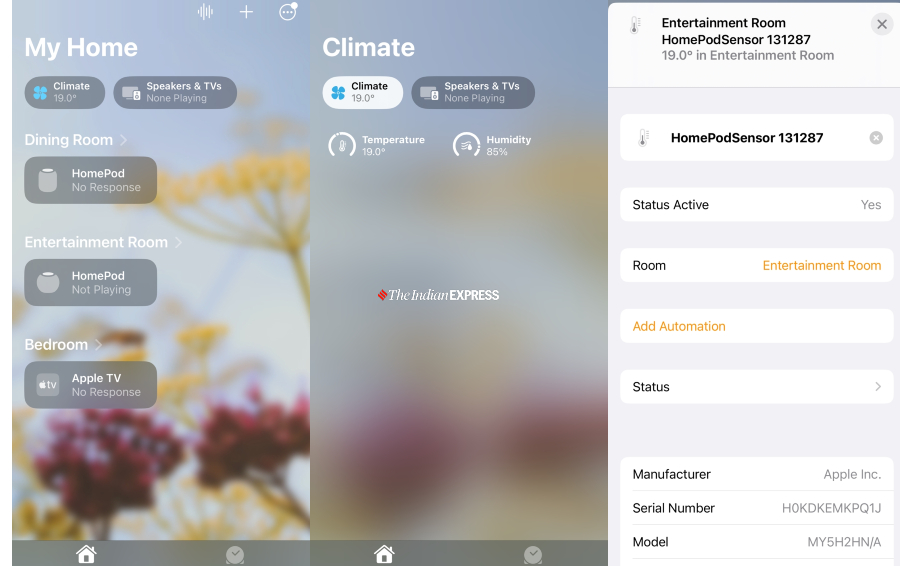Here’s how temperature and humidity sensors work on HomePod mini
The latest HomePod mini's software update lets you check the temperature and humidity in your home.
 The HomePod mini is fully integrated with Apple's smart home system. (Image credit: Anuj Bhatia/Indian Express)
The HomePod mini is fully integrated with Apple's smart home system. (Image credit: Anuj Bhatia/Indian Express) When Apple announced the second-generation HomePod last week, the news came as a surprise to many. The full-sized HomePod 2 has many new features including an improved sound with a built-in bass-EQ mic, and has an internal temperature and humidity sensor for recognizing the internal environment.
While the next-gen HomePod hogged all the attention, the HomePod mini is also getting a bunch of new features. With HomePod 16.3 rolling out this week, the HomePod mini will be getting the same smart home features as the newer, second-generation HomePod.
We tried the HomePod 16.3 beta ahead of release, and here’s how some of the new temperature and humidity sensors work on Apple’s smallest speaker.
Temperature and humidity sensors
HomePod mini always had a temperature and humidity sensor built-in, but Apple never enabled them. With HomePod 16.3 software version ready to download, the mini will be able to monitor the temperature and humidity in the room. To see the readings, the first thing you need to do is to update the Home app for iOS and iPad OS to iOS 16.3 (likely roll out this week). Since we downloaded the HomePod software version 16.3, we were able to preview all the upcoming features coming to HomePod ahead of time.
Anyway, once we updated our HomePod mini, a new Climate shortcut appeared on top of the screen, which showed the readings of the temperature and humidity sensor in the room. If you own more than one HomePod mini, and since there are multiple sensors in the room, it will display an average of them. You can tap the reading to get to the individual sensor’s readings and settings.
As observed in our testing, the mini’s sensors aren’t quick to give you the readings. They only read “calibrating” as they adjust to the surroundings. After a few minutes, the app gets updated with the current readings. As usual, you can always ask Siri about the temperature in the room. Unfortunately, though, there is no way the app sends a notification when the temperature or humidity changes drastically.
There is also an option to create automations from the settings menu and do things like shutting the blinds or trigger some smart home appliances to respond to the temperature or humidity rising above or low the treshmark. You can, of course, set the parameters using the time (any time, during the day, at night, or at specific times) and/or people (when somebody is home or nobody is at home).
 The HomePod mini’s temperature and humidity sensors take some time to show the readings. They aren’t as quick as we originally hoped.
The HomePod mini’s temperature and humidity sensors take some time to show the readings. They aren’t as quick as we originally hoped.
Apple is getting serious about smart home strategy
HomePod mini users will soon be able to try out many new features like the ability to add remastered ambient sounds to scenes, automations, and alarms, as well as the ability to use Siri to set recurring automations and find people who are in your Find My contacts.
The relaunch of the full-size HomePod and the mini’s new humidity and temperature sensors that were hidden since launch shows that Apple is on track with its smart home efforts. No matter what critics say Apple still has a major advantage over Google and Amazon: trust in the brand to protect their personal information. With Google and Amazon under pressure to make changes to their hardware divisions amid a slowdown in tech, Apple could take advantage of the situation and start focusing on its smart home strategy.
Apple’s strategy, for now, looks like it will continue to offer products that target different price segments. The HomePod 2, for instance, is still a premium smart speaker but at the same time, the HomePod mini is less expensive, and offers the same home functionality as the high-end smart speaker. With Apple reportedly working on a smart speaker with a display, similar to the Amazon Echo Show 10, that would combine the HomePod and Apple TV with a camera, it appears that Cupertino’s smart home products will only get stronger in the future.







